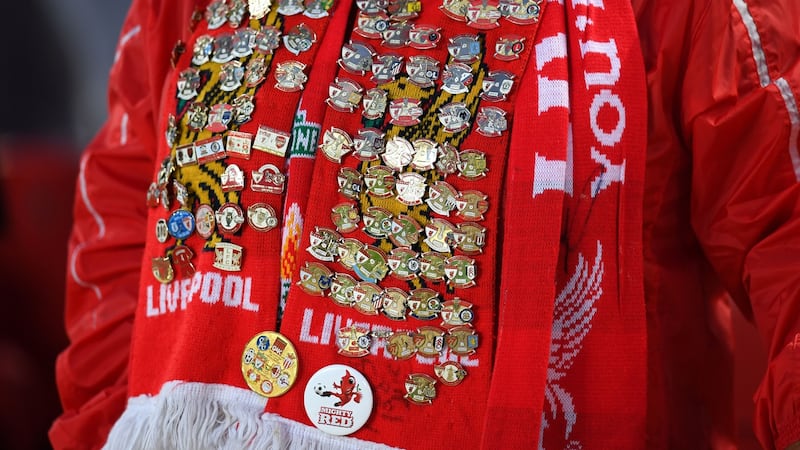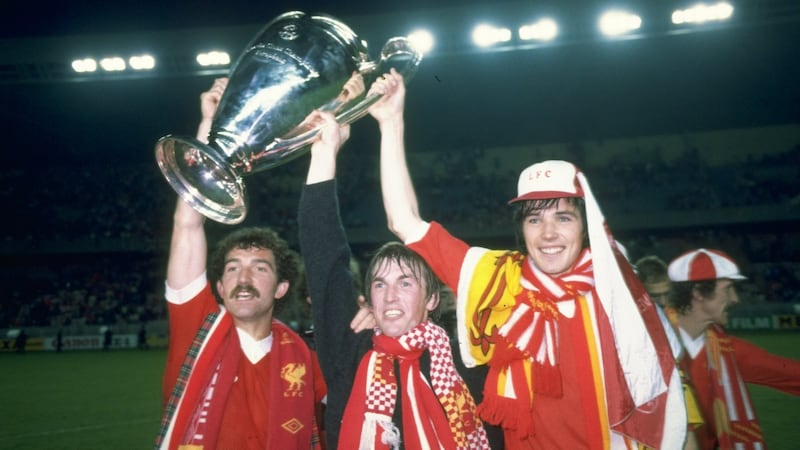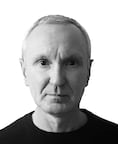Monday morning, Albert Dock and the Museum of Liverpool is buzzing five minutes after opening. An exhibition, Double Fantasy, about John Lennon and Yoko Ono is the new pull. It is smart, funny and moving. There is a quotation from Yoko Ono at the entrance: "A dream you dream alone is only a dream. A dream we dream together is reality."
It is the sort of phrase-making co-opted by football clubs these days, or plastered on one of those tiresome banners. But here, in this context, it is convincing, real.
An hour later, outside Anfield, there is another buzz. This too is real. It comes from those in the lengthening queue weaving from the ticket office and around the Shankly statue which stands on guard at the back of the Kop.
Snatched conversations are about dates, airports, tickets. You can hear the anticipation, the dreams.
Inside the storied stadium, they are there again. "A dream come true," says Dejan Lovren of Liverpool's arrival at another Champions League final. Beside him Sadio Mane agrees with a broad smile. In came Jurgen Klopp to speak of "dreams, big dreams".
Dreams, tickets and tales, ‘twas ever thus at Anfield.
Honeymoon
Gerry Marsden, the man who inadvertently transformed You'll Never Walk Alone from the musical Carousel into a Liverpool FC anthem, once told the story of how his marriage was arranged in October 1965 without consulting the fixture list. It was a few days before Liverpool played Juventus, a big European night. Marsden postponed his honeymoon.
“I rang Bill and asked if he’d any tickets,” Marsden said of Shankly. “He said there weren’t any left.”
Marsden had that no-ticket anxiety. Shankly came to the rescue. Marsden was given Shankly’s seat in the directors’ box. “That’s the kind of man he was,” Marsden said. Liverpool won 2-0.
So many stories, so many memories, in a red flush of a week, it can feel like a state of self-commemoration. As Klopp spoke in the adjoining room reruns of the 1978 and 1981 European Cup finals were being shown. 1-0, 1-0: Kenny Dalglish’s chip against Bruges, Alan Kennedy’s surge past Real Madrid.
In a sharp-tongue environment, Kennedy was the butt of one of the finest cuts of them all, Bob Paisley’s withering half-time response to the full-back’s debut – “they shot the wrong Kennedy”.
The tenor, the bite in that remark reflected the location. “They’re that kind of people,” Shankly said of Liverpudlians. “They’re arrogant, they’re cocky – and that’s what I wanted the team to be.”
Self-expression
Neither Shankly nor Paisley came from the place, but they grasped its sense of itself, football’s role in its self-expression, and they honed it.
"Liverpool is a city that has a love of football running through its veins," says Janet Dugdale, director of the museum. "We've experienced many highs and some incredible lows, which have only served to bind us together. Being a football fan in Liverpool is something unique and unwavering."
Fans in other English towns and cities will dispute that unique claim. But from within, they are adamant. All tickets for Saturday’s beamback at Anfield have been sold, street hoardings advertise various deals at various venues. “Doors open from 2pm”; “Afterparty”.
"There can be few places other than in Liverpool where football has quite the specific cultural resonances that it has," wrote John Williams in his biography of Liverpool FC Red Men.

Williams notes geography, culture, attitude. “As far back as the 1930s you’d get reporters writing about the Kop in anthropological terms, that it and Liverpool were somehow different.
“And Liverpool is different from other English cities – it does have that sense of otherness. When the south practically accused Liverpool of that, Liverpudlians said: ‘okay, we’ll have that. We are different’.”
Success also makes a difference. It separates and enhances. Liverpool Football Club was formed in 1892, but the modern Liverpool – the one that wins European trophies, dominated England and resides in a fabled ground – began with the Scottish firestarter Shankly.
Visionary
"A beam shone out of him," Joe Fagan said. "We were going nowhere, but the whole club changed when Bill arrived. It started to vibrate."
When Shankly walked in the door, alone, in December 1959, Liverpool were in the old Second Division and had been since 1954. His first match was a 4-0 home defeat by Cardiff City. There were 27,000 at Anfield. It takes a visionary to say: “There was only potential.”
In a previous job at Carlisle United, Shankly had burnt all the team kit in a demonstration of his urgency. At Anfield his first demand was a new irrigation system for the pitch, and by 1964 Liverpool were champions of England. “It’s great grass at Anfield,” Shankly said. “Professional grass.”
The torrent that flows today had its source. Glory, trophies and story upon story.
John Toshack recalled this week being met by Shankly at Lime Street station after his transfer from Cardiff. Shankly's greeting was: "Son, you've left Sunday school and come to church."
Dalglish did not sign for Liverpool until 1977, but he was on trial at Anfield under Shankly in 1966. Not long after his 15th birthday, Dalglish was on the bus from Anfield to the Melwood training ground. Roger Hunt, Ian Callaghan, Ron Yeats and Ian St John were just some of those on board.
“These famous men on the bus to Melwood,” Dalglish said, “were responsible for setting down Liverpool’s traditions: camaraderie, banter, hard work and a passion for the shirt. Liverpool’s DNA. The man inspiring most awe in my impressionable mind was the manager.”
Winning stories
Shankly choreographed winning football and from that winning stories. Banter is a devalued term, but rereading Dalglish's My Liverpool Home, it becomes clear how much it meant in terms of club culture. It could be harsh – Ian Rush almost left because of it – but layer upon layer of humour, commitment and talent left foundations. Paisley built a European empire on them.
Tommy Smith was so tough Shankly said he wasn't born, he'd been "quarried". But Smith was not beyond rebuke, even when injured. "What do you mean, your knee?" Shankly scolded him. "It's Liverpool's knee."
Obsessive, possessive: Shankly was the personification of the Red fanatics of later decades and today. Attitude was passed down like other traditions, superstitions too. The great Paisley team of the 1970s were consumed by their pre-match biscuit ritual.
“The rotation of the biscuits was carefully orchestrated,” Dalglish said. “Rotation was a staple of life long before Rafa Benitez.”
Benitez got the connection, the prevailing sarcasm. On the night of Istanbul in 2005, the Champions League trophy was placed at the centre of the post-match party. At its end, Benitez said: "Steven Gerrard decided only he would be able to keep the cup safe, and so it spent the night with him. It belonged, though, to all of us." Gerrard-Benitez, obsessive-possessive. Benitez also wrote a book, Champions League Dreams.
Irish stew
That “otherness” Williams referred to – and others – also play a role in Liverpool’s football story.
There is the Irish dimension – academics say the food “scouse” from which the Scouser term derives is essentially Irish stew.
The on-the-pitch Irish influence may have dwindled since the Ronnie Whelan era, though Steve Finnan played in Istanbul, and teenaged Dubliner Conor Masterson is coming through. There was also Brendan Rodgers, who came so close.
In the stands those travelling Irish supporters never stop. Sadly, Sean Cox suffered for that when attacked by Roma fans before the first leg of the semi-final. Another innocent Irish bystander, Patrick Radcliffe from Belfast, was killed at Heysel in 1985.

On Monday morning an Irish accent could be heard as Liverpool's squad stretched and passed and Klopp looked on. It was that of Conall Murtagh.
Murtagh is 32, and Liverpool’s first-team fitness coach. Via Aquinas in south Belfast through Crusaders, Wrexham and university, Murtagh is unlikely to forget overseeing the Anfield training session before Kiev.
And a couple of hundred yards from Anfield, The Sandon still stands. “Birthplace of Liverpool FC”, it says on the outside. John McKenna from Monaghan was once a regular there.
McKenna, “Honest John”, became one of the Liverpool FC’s originals. An Anfield board member until 1922, McKenna lived nearby on Castlewood Road. His modest house also stands.
McKenna witnessed the rupture from which Liverpool FC were born, when Everton – the others who were the first occupants of Anfield – moved down the road to what would become Goodison Park.
Ticket prices
There was tension then. In the 100-plus years since there has been some more of that, but also harmony. Civic awareness meant that both clubs, for example, dropped ticket prices during the second World War, and both were fined by the Football League for it. Civic rivalry, meanwhile, meant the pair spurred on each other.
When Liverpool won that League title in 1964, it was after Everton won it in 1963. When Everton won the FA Cup in 1966, it was after Liverpool won it in 1965. When Liverpool’s mid-1980s titles were stopped, it was by Everton.
Then, in the worst of times for Liverpool, Everton were central. The ban on English clubs in Europe after Heysel affected Everton, who had just been crowned league champions. Four years later as the horror of Hillsborough unfolded, that afternoon Everton were in the other FA Cup semi-final at Villa Park. They won and players were celebrating reaching Wembley when told of the news from Sheffield.
Led by manager Colin Harvey, a Liverpudlian, Everton's team went to Anfield to see the expanse of floral tributes. They laid a wreath. The silent stadium broke into applause.
As Dugdale says, events and reactions bind the clubs to its city and the city to its clubs.
This does not mean Evertonians will share those Liverpool dreams. More like dread.
Liverpool fans may also have noted that the word “dream” on the club website has gone. It has been replaced by “believe”. Men like Mo Salah start that kind of thing, hitting the back of the net again and again.
Maybe someone told Salah that the man who invented goal nets way back in 1889 came from Liverpool. He did. John Brodie. He supported Everton.
















